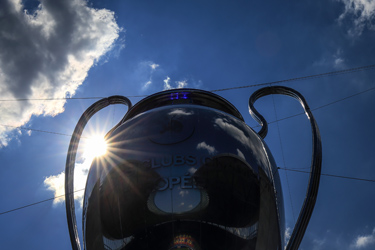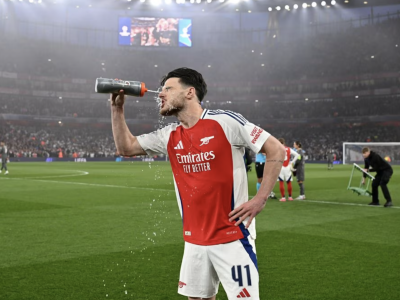I was fortunate enough to be in attendance at the Champions League Final in Berlin’s impressive (even allowing for the running track) Olympiastadion yesterday evening, and it gives me an excuse to post some fresh content on the site.
It struck me that since Barcelona played Arsenal nine years ago, the fortunes of the two sides have changed dramatically. Barcelona had not appeared in the final for 12 years then, the Gunners never. The Champions League format has allowed the two sides to continue participating in the tournament habitually ever since. History tells us that Barca were a team on the rise, Arsenal about to decline. The Catalans have appeared in three finals in the following nine campaigns, winning every one. They have also made a number of semi-finals. The Gunners, in the same time, have made a solitary semi in 2009.
The move to the new stadium is the most obvious reason for the gap in achievements between the two sides, although there are certainly other factors. However, the bottom line can be reflected in the purchase of Luis Suarez. Barca paid £75 million for a player that was banned for the early part of the season. Arsenal, with the player in the same position, wouldn’t go to the £55 million that would have secured him a year earlier, once it became apparent that the reputed £40 million release clause was anything but. The Gunners ended up shelling out £42 milliion for Mesut Ozil instead, which is not a bad thing, but wasn’t what they needed to win the title.
The simple fact is that Barcelona still have more resources than the Gunners, although the current ban on transfer activity invoked by FIFA means the Catalan side cannot use it to buy new players this summer (or strengthen last January). It’s a chance to catch up, and viewers of last night’s final can judge for themselves how big the gap is.
The game itself was corker for a European final, aided greatly by Rakitic’s early goal. The replacement for the departing legend Xavi does not score often, but looks well worth the £18 million transfer fee reputedly paid to Sevilla to secure his services. On the quality of the first half chances, the game could have been dead and buried by the interval, but as a spectacle, that Juventus had the opportunity to make a game of it in the second half turned it into an excellent football match. Their attack got their act together and after a well-worked equalizer, for a brief spell they looked like the more likely winners. The game was far more open than many a European final and there was some enthralling football as a consequence. The atmosphere was cracking throughout, with both sets of supporters highly vocal. In truth, I don’t think the kind of regular attendees at Arsenal matches (who would get final tickets) would ever make this kind of racket, a reflection that the more vocal type of supporter has gradually been priced out of the game in England. You can disguise this on TV with the use of volume levels on microphones to amplify the slightest buzz, but in the flesh, nobody’s fooled.
Barcelona fathomed the better chances and were more clinical, although with better finishing, Juve could have won the trophy. At 2-1 down, they created enough opportunities to have taken the game to extra time, but it was not to be. Neymar’s goal was the final kick of the final and largely academic. Xavi came on for a triumphant send off, whilst Andrea Pirlo, playing his final game for Juventus, suffered the unhappy ending, although he has plenty of winners’ medals to look back upon. Both players will be a great loss to the game. Luis Suarez scored the decisive goal, but ultimately, his finishing wasn’t the best for the rest of the match.
Barcelona do defend pretty tightly under Luis Enrique, and the bottom line is that they have arguably three of the four best attacking players in the world in their line-up. It is almost literally irresistible. Suarez is the oldest at 28, which suggests there may be another three seasons with this attack, and with that strikeforce, I wouldn’t bet against them defending the trophy.
They aren’t the same side that beat Arsenal in two consecutive seasons in 2010 and 2011. Without Xavi, there is a little less of the tikka takka, and they are gradually evolving, with more goals being scored at pace rather than defences being systematically picked apart with precision passing (although the opening goal showed they can still score this way). The speed of the forward line is something that Arsenal might need to consider when weighing up how to beat the very top sides in Europe. Arsene Wenger certainly has quick players at his disposal, although this side of their game is not seen often. Perhaps it is time to evolve, as Barca have done. The game doesn’t stand still for anyone.
Juventus played brilliantly to eliminate Real Madrid in their semi, but asking them to overcome Spain’s other major force on top of that proved a little too much. Nevertheless they contributed to a memorable final. For a number of the players that took part last night, the season isn’t over. There is the round of Euro2016 qualifiers, whilst the Copa America means some of the South American players will be playing on July 4th. The Emirates Cup arrives three weekends later for those who might think the close season is a bit on the long side…
I will be writing occasionally over the course of the summer to keep the website simmering. For those that do want a complete break from football, see you in August!
The Annual Gooner Survey will be online in the next few days
I am now on Twitter@KevinWhitcher01.
The current issue of The Gooner, a 64 page cup final special for £3 can be bought online here.
DIGITAL ISSUES
The Gooner is also available in digital form, through The Gooner App on iPhones and iPads, the Exactly App for Android devices and now Kindle Fire owners can also get their fix by searching the Amazon App Store for The Gooner.
You can also subscribe at www.exacteditions.com and read it through your internet browser as well as receiving a code which will enable you to access issues on all the above devices.
All digital subscriptions include access to our digital back issue library which dates back to August 2010.







